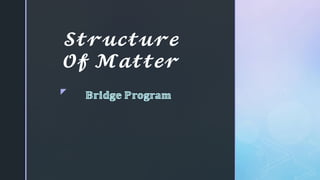
𝓢𝓽𝓻𝓾𝓬𝓽𝓾𝓻𝓮 𝓞𝓯 𝓜𝓪𝓽𝓽𝓮𝓻_ 𝔹𝕣𝕚𝕕𝕘𝕖 ℙ𝕣𝕠𝕘𝕣𝕒𝕞 (1) - Copy.pdf
- 2. z ▪ 𝕀𝕟 ℙ𝕣𝕖𝕧𝕚𝕠𝕦𝕤 𝕤𝕥𝕒𝕟𝕕𝕒𝕣𝕕 𝕪𝕠𝕦 𝕙𝕒𝕧𝕖 𝕝𝕖𝕒𝕣𝕟𝕥 𝕨𝕙𝕒𝕥 𝕒𝕣𝕖 𝕒𝕥𝕠𝕞𝕤 , 𝕔𝕠𝕞𝕡𝕠𝕦𝕟𝕕𝕤 , 𝕞𝕠𝕝𝕖𝕔𝕦𝕝𝕖𝕤 , 𝕖𝕝𝕖𝕞𝕖𝕟𝕥𝕤 𝕒𝕟𝕕 ℙ𝕖𝕣𝕚𝕠𝕕𝕚𝕔 𝕥𝕒𝕓𝕝𝕖. ▪ 𝔹𝕦𝕥 𝕚𝕟 𝕥𝕙𝕚𝕤 𝕤𝕥𝕒𝕟𝕕𝕒𝕣𝕕 𝕨𝕖 𝕒𝕣𝕖 𝕘𝕠𝕚𝕟𝕘 𝕥𝕠 𝕝𝕖𝕒𝕣𝕟 𝕖𝕧𝕖𝕣𝕪𝕥𝕙𝕚𝕟𝕘 𝕚𝕟 𝕕𝕖𝕥𝕒𝕚𝕝. ▪ 𝕋𝕠 𝕣𝕖𝕔𝕒𝕝𝕝 𝕠𝕦𝕣 𝕔𝕠𝕟𝕔𝕖𝕡𝕥𝕤 𝕝𝕖𝕥'𝕤 𝕤𝕖𝕖 𝕥𝕙𝕚𝕤 𝕓𝕣𝕚𝕕𝕘𝕖 𝕡𝕣𝕠𝕘𝕣𝕒𝕞. Objective
- 3. z Atomic Models ▪ In the 18th and 19th centuries, many scientists attempted to explain the structure of the atom with the help of atomic models. Each of these models had their own merits and demerits and were pivotal to the development of the modern atomic model. The most notable contributions to the field were by the scientists such as John Dalton, J.J. Thomson, Ernest Rutherford and Niels Bohr. Their ideas on the structure of the atom are discussed in this subsection.
- 4. z Dalton’s Atomic Theory ▪ The English chemist John Dalton suggested that all matter is made up of atoms, which were indivisible and indestructible. He also stated that all the atoms of an element were exactly the same, but the atoms of different elements differ in size and mass. ▪ Chemical reactions, according to Dalton’s atomic theory, involve a rearrangement of atoms to form products. According to the postulates proposed by Dalton, the atomic structure comprised atoms, the smallest particle responsible for the chemical reactions to occur. ▪ The following are the postulates of his theory: ▪ Every matter is made up of atoms. ▪ Atoms are indivisible. ▪ Specific elements have only one type of atoms in them. ▪ Each atom has its own constant mass that varies from element to element. ▪ Atoms undergo rearrangement during a chemical reaction. ▪ Atoms can neither be created nor be destroyed but can be transformed from one form to another. ▪ Dalton’s atomic theory successfully explained the Laws of chemical reactions, namely, the Law of conservation of mass, Law of constant properties, Law of multiple proportions and Law of reciprocal proportions.
- 5. z Atoms and Molecules Definition ▪ Atoms are much too small to be seen; hence experiments to find out their structure and behavior have to be conducted with large numbers of them. From the results of these experiments we may attempt to construct a hypothetical model of an atom that behaves like the true atom. ▪ Molecules consist of one or more atoms bound together by covalent (chemical) bonds. Atoms may be depicted by circle shapes, each of which has a nucleus at the center (containing protons and neutrons), surrounded by one or more concentric circles representing the ‘shells’ or ‘levels’ in which the electrons surrounding the nucleus of the atom are located and markings indicating the electron.at each level. A molecule is the smallest thing a substance can be divided into while remaining the same substance. It is made up of two or more atoms that are bound together by chemical bonding.
- 7. z Atoms ▪ Atom ,smallest unit into which matter can be divided without the release of electrically charged particles. It also is the smallest unit of matter that has the characteristic properties of a chemical element. As such, the atom is the basic building block of chemistry.
- 8. z What is Atomic Structure ? The atomic structure of an element refers to the constitution of its nucleus and the arrangement of the electrons around it. Primarily, the atomic structure of matter is made up of protons, electrons and neutrons. The protons and neutrons make up the nucleus of the atom, which is surrounded by the electrons belonging to the atom. The atomic number of an element describes the total number of protons in its nucleus.
- 11. z Important Points :- ▪ Every atom has a nucleus that bounds one or more electrons around it. ▪ The nucleus has typically a similar number of protons and neutrons which are together known as nucleons. ▪ The protons are positively charged, electrons are negatively charged and neutrons are neutral.
- 12. z Molecules ▪ A molecule is defined as the smallest unit of a compound that contains the chemical properties of the compound. ▪ Molecules are made up of groups of atoms. Describing the structureof an atom, an atom is also sub-divided into smaller units.
- 13. z Examples of Molecules ▪ A molecule is a collection of two or more atoms that make up the smallest recognizable unit into which a pure material may be split while maintaining its makeup and chemical characteristics. Some examples of molecules are ▪ H2O (water) ▪ N2 (nitrogen) ▪ O3 (ozone) ▪ CaO (calcium oxide) ▪ C6H12O6 (glucose, a type of sugar) ▪ NaCl (table salt)
- 14. z A table of the chemical elements arranged in order of atomic number, usually in rows, so that elements with similar atomic structure (and hence similar chemical properties) appear in vertical columns.